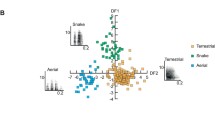Abstract
Some animals have the cognitive capacity to differentiate between different species of predators and generate different alarm calls in response. However, the presence of any addition information that might be encoded into alarm calls has been largely unexplored. In the present study, three similar-sized human females walked through a Gunnison’s prairie dog (Cynomys gunnisoni) colony wearing each of three different-colored shirts: blue, green, and yellow. We recorded the alarm calls and used discriminant function analysis to assess whether the calls for the different-colored shirts were significantly different. The results showed that the alarm calls for the blue and the yellow shirts were significantly different, but the green shirt calls were not significantly different from the calls for the yellow shirt. The colors that were detected, with corresponding encoding into alarm calls, reflect the visual perceptual abilities of the prairie dogs. This study suggests that prairie dogs are able to incorporate labels about the individual characteristics of predators into their alarm calls, and that the complexity of information contained in animal alarm calls may be greater than has been previously believed.


Similar content being viewed by others
References
Beynon P, Rasa OAE (1989) Do dwarf mongooses have a language? warning vocalizations transmit complex information. S Afr Tydsk Weten 85:447
Blumstein DT, Armitage KB (1997) Alarm calling in yellow-bellied marmots: I. The meaning of situationally variable alarm calls. Anim Behav 53:143–171
Evans CS (1997) Referential signals. In: Owings DH, Beecher MD, Thompson NS (eds) Perspectives in Ethology, vol 12. Plenum, New York, pp 99–143
Evans CS, Evans L (1999) Chicken calls are functionally referential. Anim Behav 58:307–319
Evans CS, Evans L, Marler P (1993) On the meaning of alarm calls: functional reference in an avian vocal system. Anim Behav 46:23–38
Frederiksen JK, Slobodchikoff CN (2007) Referential specificity in the alarm calls of the black-tailed prairie dog. Ethol Ecol Evol 19:87–99
Greene E, Meagher T (1998) Red squirrels, Tamiasciurus hudsonicus, produce predator-class specific alarm calls. Anim Behav 55:511–518
Gyger M, Marler P, Pickert R (1987) Semantics of an avian alarm call system: the male domestic fowl, Gallus domesticus. Behaviour 102:15–40
Jacobs GH, Pulliam KA (1973) Vision in the prairie dog: spectral sensitivity and color vision. J Comp Physiol Psych 84:240–245
Kirchhof J, Hammerschmidt K (2006) Functionally referential alarm calls in tamarins (Saguinus fuscicollis and Saguinus mystax): evidence from playback experiments. Ethology 112:346–354
Kiriazis J, Slobodchikoff CN (2006) Perceptual specificity in the alarm calls of Gunnison’s prairie dogs. Behav Processes 73:29–35
Leydet F (1977) The coyote: defiant songdog of the west. Chronicle Books, San Francisco
Manser MB (2001) The acoustic structure of suricates’ alarm calls varies with predator type and the level of response urgency. Proc R Soc Lond B 268:2315–2324
Manser MB, Bell MB, Fletcher LB (2001) The information that receivers extract from alarm calls in suricates. Proc R Soc Lond B 268:2185–2491
Owings DH, Hennessy DF (1984) The importance of variation in sciurid visual and vocal communication. In: Murie JO, Michener GR (eds) The biology of ground dwelling squirrels. University of Nebraska Press, Lincoln, pp 171–200
Placer J, Slobodchikoff CN (2000) A fuzzy-neural system for identification of species-specific alarm calls of Gunnison’s prairie dogs. Behav Processes 52:1–9
Placer J, Slobodchikoff CN (2001) Developing new metrics for the investigation of animal vocalizations. Intell Autom Soft Comput 7:1–11
Placer J, Slobodchikoff CN (2004) A method for identifying sounds used in the classification of alarm calls. Behavioural Processes 67:87–98
Placer J, Slobodchikoff CN, Burns J, Placer J, Middleton R (2006) Using self-organizing maps to recognize acoustic units associated with information content in anaimal vocalizations. J Acoust Soc Am 119:3140–3146
Seyfarth RM, Cheney DL, Marler P (1980) Monkey responses to three different alarm calls: evidence for predator classification and semantic communication. Science 210:801–803
Slobodchikoff CN (2002) Cognition and communication in prairie dogs. In: Bekoff M, Allen C, Burgardt GM (eds) The cognitive animal. MIT Press, Cambridge, pp 257–264
Slobodchikoff CN, Placer J (2006) Acoustic structures in the alarm calls of Gunnison’s prairie dogs. J Acoust Soc Am 119:3153–3260
Slobodchikoff CN, Kiriazis J, Fischer C, Creef E (1991) Semantic information distinguishing individual predators in the alarm calls of Gunnison’s prairie dogs. Anim Behav 42:712–719
Templeton CN, Greene E, Davis K (2005) Allometry of alarm calls: black-capped chickadees encode information about predator size. Science 308:1934–1937
Verdolin J, Slobodchikoff CN (2002) Vigilance and predation risk in Gunnison’s prairie dogs. Can J Zool 80:1197–1203
Warkentin KJ, Keeley ATH, Hare JF (2001) Repetitive calls of juvenile Richardson’s ground squirrels (Spermophilus richardsonii) communicate response urgency. Can J Zool 79:569–573
Zuberbühler K (2000) Referential labelling in Diana monkeys. Anim Behav 59:917–927
Zuberbühler K (2001) Predator-specific alarm calls in Campbell’s monkeys, Cercopithecus campbelli. Behav Ecol Sociobiol 50:414–422
Author information
Authors and Affiliations
Corresponding author
Rights and permissions
About this article
Cite this article
Slobodchikoff, C.N., Paseka, A. & Verdolin, J.L. Prairie dog alarm calls encode labels about predator colors. Anim Cogn 12, 435–439 (2009). https://doi.org/10.1007/s10071-008-0203-y
Received:
Revised:
Accepted:
Published:
Issue Date:
DOI: https://doi.org/10.1007/s10071-008-0203-y




